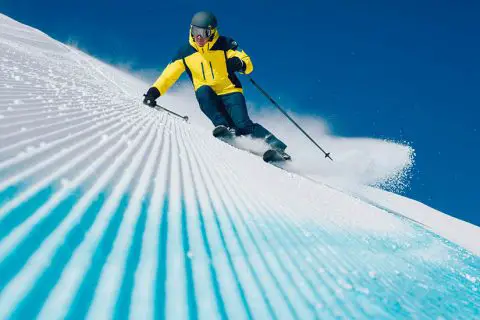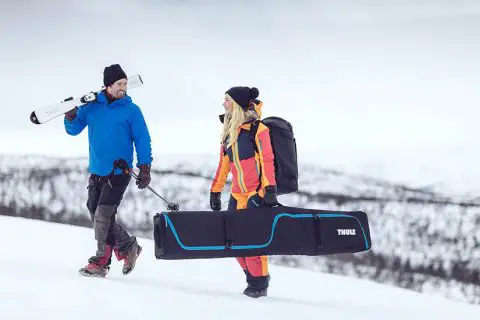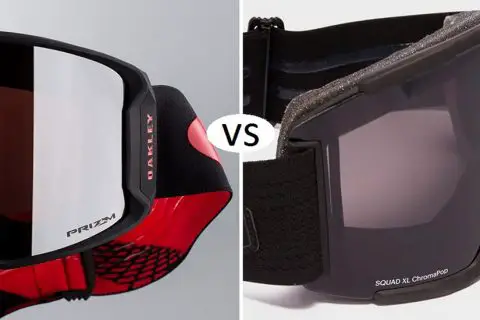Are you in search of most comfortable ski boots that perfectly suit your style, easy to get into and works wonder on the ski hill? Worry no more; we have got your back. With the collection of the best ski boots, you will surely find your choice. But wait a minute. You need to understand the features in a ski boot. Knowing this will give you an edge when making a decision of a brand that best fits your taste and matches your expectations.
| Name | Features | |
|---|---|---|
| Apex HP All-Mountain | Incredibly Adjustable With the BOA Design | PRICING |
| Atomic Live Fit 80 | Very Versatile and Usable by Many Categories of Skiers | PRICING |
| Dalbello DS 90 | It has My Fit shell | PRICING |
| Dalbello DS 90 W | High Density Ultralon EVA Foam | PRICING |
| Black Diamond Quadrant | It Features a Three Density Triax Frame | PRICING |
| First Degree ST2 120 TF | 5 Step Forward Lean Mechanism | PRICING |
| First Degree ST1 100 TF | Vibram Outsole (DIN Compatible) | PRICING |
Ski Boot Construction
The ski boot must have a hard outer shell to provide excellent support and a soft liner for warmth and cushioning. Many boots have “front-entry overlap” designs. This means they’re open in the front area like hiking boots while being secured by three or four buckles. You may find “rear entry” in some kids’ boots.
Focus on Fit and Performance
For the right boot that fit, style and color come second. Consider fit and performance. Those are a few things that matter before other considerations.
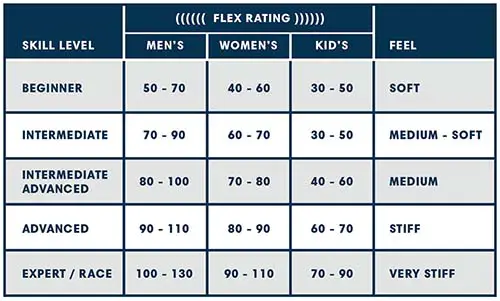
Soft Flex
Go for soft flexing boot; they’re very comfortable. If you’re new to the sport, you’ll love it – or even if you have been skiing for a while but you do it at leisure on the groomed green. If you expect to progress much quicker, go a bit higher.
Medium Flex
Medium flex is designed for intermediate skiers and comes with increased responsiveness for better turn-carving skills and higher speeds. They’re suitable for individuals who can ski blues and easier black runs, as well those ready to handle steeper terrain and ungroomed snow.
Stiff Flex
Stiff-flex boots are for people who ski with confidence, and they’re highly responsive. It is also for those who ski with speed and are aggressive when it comes to challenging terrain. Some boots come with features like shock absorption for slamming bumps or landing jumps.
For most advanced boots, they feature multi-density materials to allow stiffness in critical areas of energy transfer, yet soft in specific locations. You will not like stiff racing boots as they can be very comfortable in use.
1. Apex HP All-Mountain Ski Boots
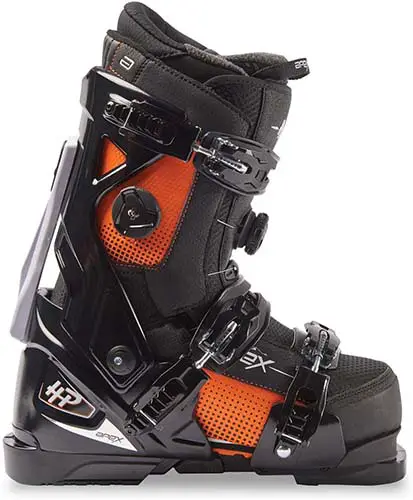
What readily comes to mind as regards the Apex HP is the innovation that comes with the boots – it is similar to a snowboarding boot alongside a ski boot exoskeleton. A lot of people were thrilled by the buzz that surrounds the concept. The boot performs perfectly well in the day lodge than on the slopes.
But innovation does not always mean functionality. To break the boundary of what is regarded as standard, you will have to think outside the box, pushing forward every minute. This boot is a bit difficult to ski even when at low speeds, allowing very round skidded turns. It is also tricky for some expert testers to make a carved turn in these boots. The expert skier was installed as a stiffening leverage arm which runs to the back of the boot.
For the fact that a snowboard boot is considered more comfortable than traditional ski boots, considerable gains in comfort were expected. However, the HP was not in any way better in comfort than the classic alpine boot. The truth be told; you may even feel less comfortable. If you lack ankle mobility, finding it difficult to adapt to a traditional plastic ski boot, these pairs may be the perfect option for you.
The Apex does not lack in features. With the BOA system, you can adjust the entire boot to your shin and foot with the help of the tow dials that ensure a snug fit in every area. Even before the liner was heat molded, the soft inner boot seems more like a custom fit after the BOA technology use. The moldable liner is the icing on the cake when it comes to having that custom feel from toes to calves. That brings a great value when you talk about the Apex HP All Mountain ski.
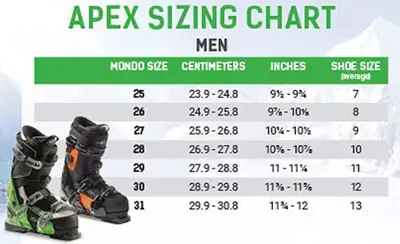 |
Pros
Cons
|
2. Atomic Live Fit 80 Ski Boots
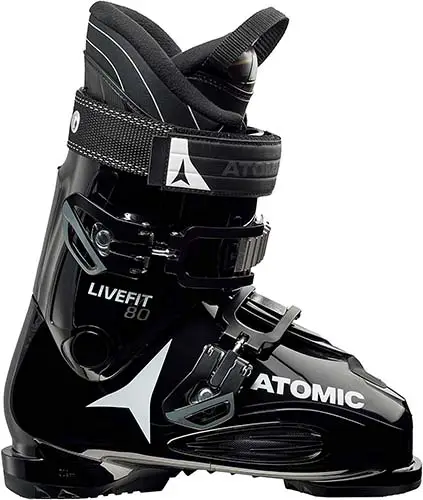
The Atomic Live Fit 80 is synonymous with comfort – and you will fall in love with it dearly for this feature. These boots were adapted from 102-106mm wide, which makes it the right choice for intermediate to advanced skiers – those with fuller feet. Time has passed when we have to spend hours at the boot fitter working to relieve pain from mangled feet—go ski with your Live Fits and enjoy. That is the benefit you now enjoy.
The boot commands a flex rating of 80 – that means moving out the softer-entry level boots and straight into the stiffer region. You’ll find it appropriate for a wide range of skiers – from the lower intermediates seeking for improvement to the experts looking for extra flex and for more adventure while skiing.
The Live Fit system has two elastic zones located at the forefoot, which immediately fit the foot width of the skier. The shell fits between 102 and 106mm. It offers a perfect fit aside from the stress of heat molding and modification of the shell – which is usually expensive. It will come as fit as a fiddle for any skier, putting smiles on their faces.
This boot comes with two oversized buckles rather than the standard four buckles system – or maybe three – which get the same fit and power. A single canting found on the outside of the ankle correct an uneven ski platform. The adjuster in the center can help pivot the boot with a change to the flex of the boot. The loop of the fabric at the top of the tongue makes it easy putting on and removing the boots. By pulling forward and to the side, your foot should find its way right in and fit perfectly too.
Skiers that do not live in ski-in/ski-out condos would crave for these boots. When your ski tech says, you need to buy new boots because the soles are worn, laugh it off and respond with a request for a unique soleplate. Atomic’s ASY (Asymmetrical) Sport liner come softer at the highest end Atomic liner—but it is considered the second-best. These fit are ergonomically and you can thermomold the liner to your foot—with an adjustment in forefoot areas and ankle. You will also find it warm and fuzzy.
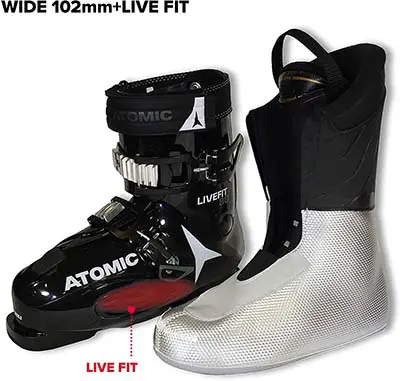 |
Pros
Cons
|
3. Dalbello DS 90 Ski Boots
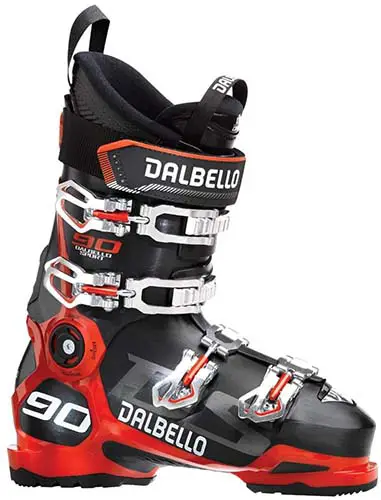
The Dalbello DS 90 ski boots feature new construction that is focused on offering the perfect combination for all-round performance and comfort. The comfort in these boots is mostly because of the lighter weight construction as well as the Dalbello’s MyFit customization features.
The design team at the Dalbello came up with a bi-injected Power Cage construction that has a hard PU frame infused with a second injection, which results in a slimmer design and also a lighter weight in all. With four buckle overlap, this light women ski boot brings excellent power transmission alongside an easy boot entry for your comfort and without any stress.
The right power, control, and precision are what the overlap design of the new DS 90 W brings to the table. The power transmission comes as direct and immediate with a precise wrap located in the heel zone of this Dalbello boot. Additionally, the boot offers more volume in the toe box and command more fit, increasing its excellent comfort in all areas.
Aside from fit, comfort, and performance, there is better blood circulation that keeps your toes and feet warm, giving rise to long days on the mountain. These boots come with great designs for those solid skiers – from advanced to expert level and everything in between.
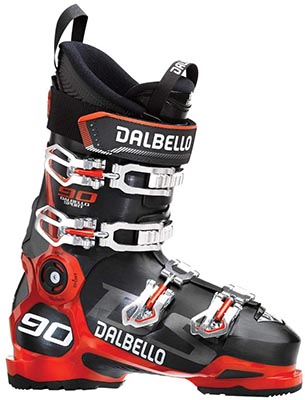 |
Pros
Cons
|
4. Black Diamond Quadrant Ski Boots
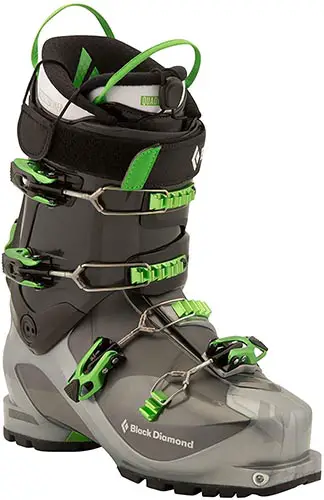
These pairs are lightweight with enough power and finesse for even the beefier skis in challenging conditions. The overlapping shell construction features an interlocking cuff that offers an excellent connection and power shift by flexing your downhills muscles. The cuff gives you freedom and case of movement when you walk and through steep sections of the uptrack.
The Pebax plastic shell comes with a pivoting cuff that provides 40 degrees of motion when unlocked for climbing. Again, the shell also brings on overlapping construction -which is common to alpine boots – and it eliminates the need for a tongue. That hinders mobility, but create high stiffness when you buckle it back all together for downhill shredding.
The liners micro-adjust with the Boa’s fast, one-handed lacing system, as it is familiar with all BD boots. More so, a rockered rubber outsole gives better traction so you can hike the icy trail as much as you’d love to.
Performance counts for both up and down and that is where the new Black Diamond Quadrant comes on so strongly – and they can never go wrong. The boot has four buckles which help in maintaining ski performance of a freeride boot and at home in the hill or backcountry. There is a lot of technology infused into the boot for a fair price and your comfort too.
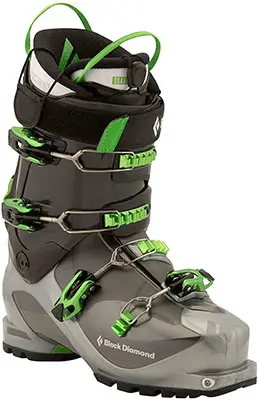 |
Pros
Cons
|
5. First Degree ST2 120 TF Boots
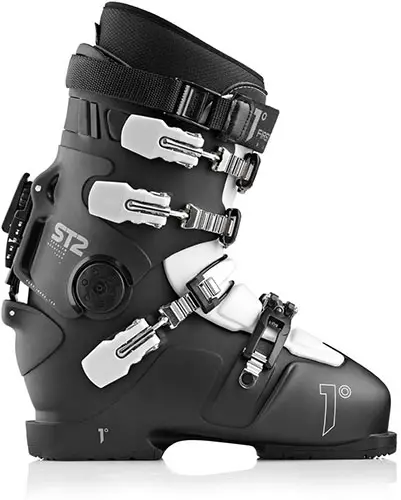
The First Degree Stormtrooper ST2 is considered an entry-level boot when it comes to ski boots. It is the idea of Icelantic Board in Denver, Colorado. These crewmen are some of the most passionate in these sports. They are always known to bring out the best. As regards the Stormtrooper boot series, they wanted to infuse the best aftermarket features into a perfect free riding shell. The mold was acquired and not built so you may recognize the shell.
Based on feedback from customers, the first edition will be improved. The Stormtrooper has two models available. And the ST2 happens to be the stiffer version. It is 110-120 on the stiffness scales – the ST1 is a softer version for less aggressive skiers. Additionally, the First Degree features a footbed which is not a throw-out like you see in every other boot. DFP has been producing these for a while, and they sure know their onion.
The toe box is somewhat narrow and will be punched out for people with a wide forefoot. It may also come to your notice that the pocket is not as tight as you would typically expect when you consider it was coming from a traditional stiff-flex boot featuring an overlapping shell.
The Stormtrooper design was for hiking, featuring an excellent walk or ski mode. The lever that resides at the back of the boot offers multiple functions as a forward lean adjuster and a walk/ski mode. It helps you determine your forward lean on the fly in the absence of shims or screws. Take, for instance, if you’re going to the park, you can make it be on an upright stance for rail sliding and switch skiing. When it’s time for a more aggressive race such as stance, you set them off in the forward lean mode.
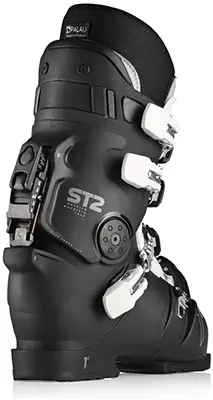 |
Pros
Cons
|
Conclusion
Skiing can be delightful, especially if you have the right pairs on. And it can be one of those nightmares you wished never came to pass if you go wrong at it. Your ski boots are at the core of a perfect ski day, and an excellent deal of fine-tuning is needed to perform at your best. The truth is that we all have different feet, so you will have to refine your boot fit to enjoy your adventure. The above reviewed products are certain to bring you options that will bring great value for your money.
You may also like:
- Best Skis for Intermediate Skiers of 2020
- Best Hard Shell Ski Jackets
- Best Ski Bags For Travel
- How to Adjust Rossignol Ski Bindings
- Ski Helmets With Built In Goggles
- What Size Ski Poles Do I Need?
- First Time Skiing Checklist
- Best Ski Gloves Under $100
- Best Ski Goggles Under $100
- How Does Avalanche Beacon Work
- How Should Ski Pants Fit?

